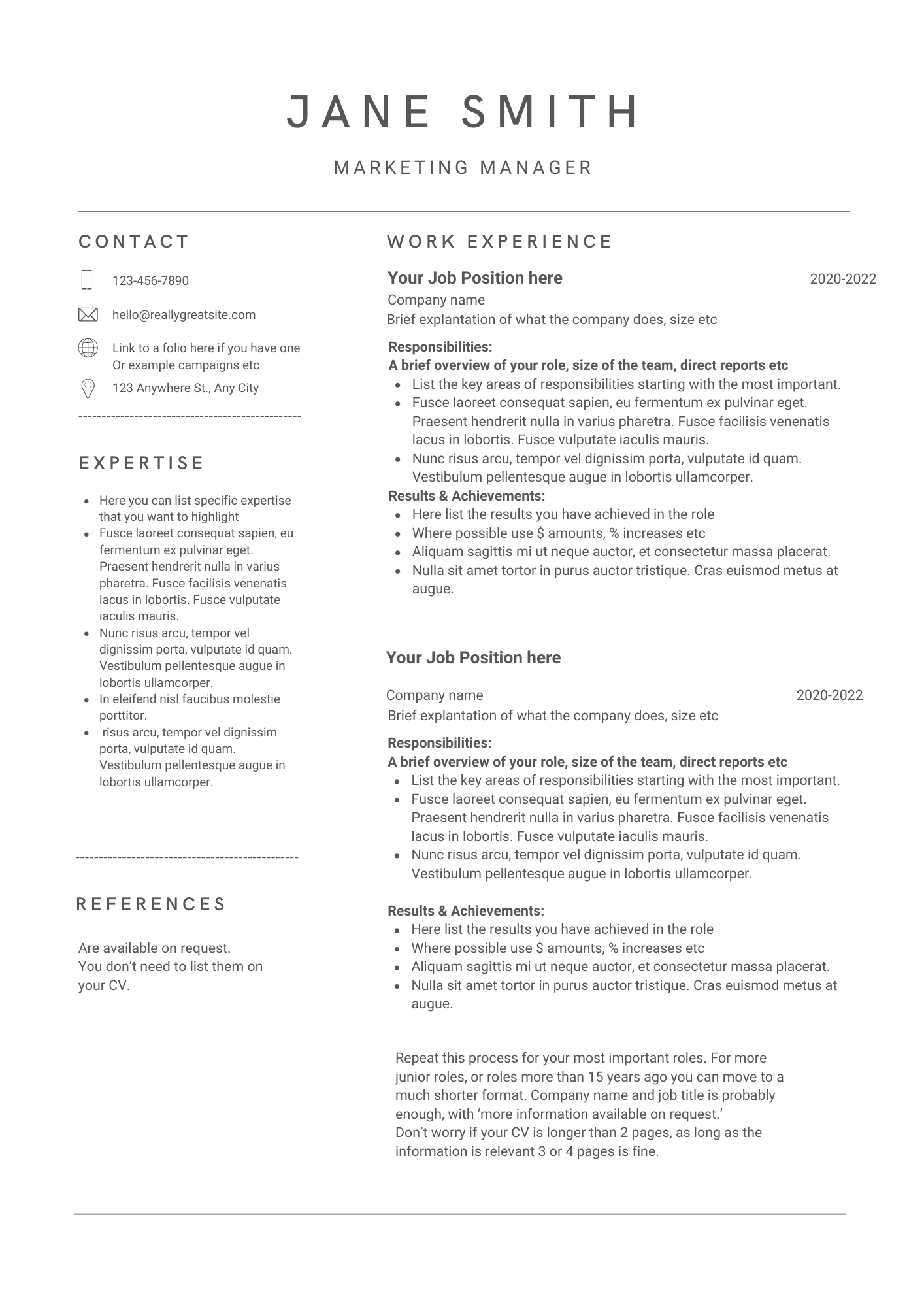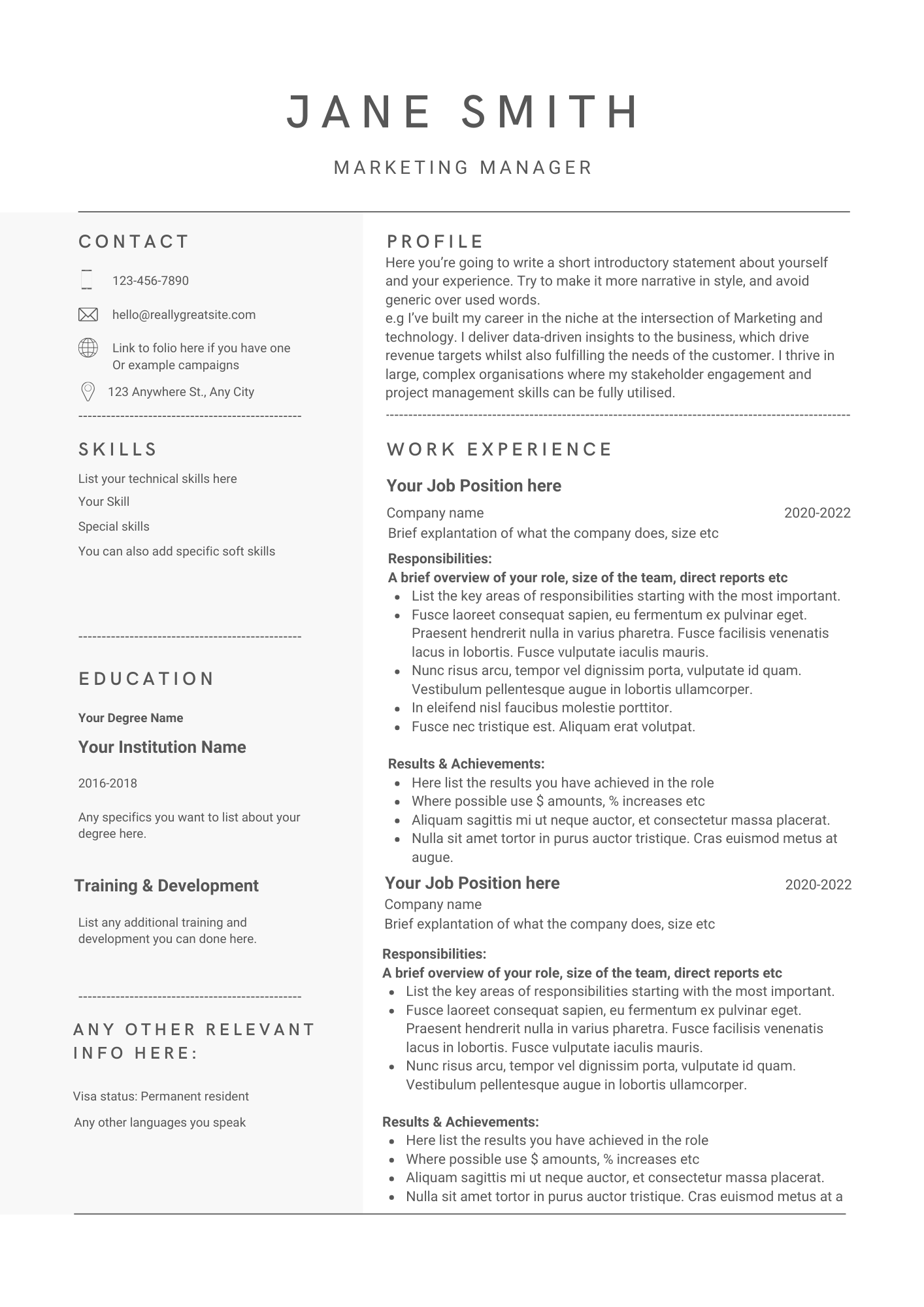Advice on writing your CV
Hi, I’m Emma. As a career coach, I help people to get clear on where they want to go, create a strategy to get there and then position themselves for success.
There are so many conflicting opinions when it comes to CVs, it can be hard to know where to start!
Below is my advice based on 25 years of experience in recruitment, training and business and the 10,000s of CVs I’ve looked at and read during that time.
I hope you find it useful.
The purpose of your CV is to get you an interview, that’s it.
Your CV should sound like you. You can be professional without being stuffy. Don’t write using formal words you would never use in real life. I find the best way to achieve this is to write it as you would say it.
Stay away from using generic words or phrases that could apply to anyone, focus on your unique value. I’ve lost count of the number of times I’ve read ‘I’m a dynamic leader’, I don’t even know what that means! Instead, write something about your preferred leadership style.
For example ‘I lead by empowering my team to use their initiative and make their own decisions’
Don’t assume that the first person to read your CV will be familiar with your industry or the specifics of what you do. Keep jargon to a minimum and keep it easy to understand.
Your CV does NOT have to be one or two pages long. I would say the opposite is true, especially once you’ve reached a certain level of experience. One or two pages is not long enough to give an adequate level of depth on what you’ve done and achieved. Around four is good, over five and I would look to cut it down.
You should have a ‘master’ version of your CV that you then customise for specific roles.
Many recruiters I know don’t read cover letters, so unless you have been asked to include one I wouldn’t spend the time on it.
Should you use AI tools like Chat GPT? I don’t think so. The language used is quite generic and when you read a lot of CVs it’s quite easy to spot the AI generated ones. Having said that AI can be helpful as a starting point to give you a framework, which you then rewrite or make more specific to you.
Design and layout:
Don’t get hung up on the format, it doesn’t matter too much. As long as it’s clear and easy to read, that’s all you need. You’ll find great templates on Seek or Canva, even via Google. The only caveat to this is if you work in the creative industry, you may want to do something which better reflects your skills. However, I would still advise keeping your CV simple and using your folio to showcase your skills. I’ve included a Canva example at the bottom of the page.
Contact details, phone, email and location. I would also include a link to your LinkedIn profile, assuming it’s fully up to date and optimised (which it should be!).
A personal profile or summary is a great way to start. I would make this quite a narrative statement, again think of it as you would say it rather than write it.
For example ‘my love of Marketing came from xxx’ or ‘my niche is at the intersection of Marketing and technology’ or ‘my background in data analytics has had a huge impact on my approach to Marketing’.
Then a few sentences or short paragraph highlighting the value that you would bring to an organisation. It’s also a good place to answer any obvious questions.
For example - I’ve recently moved to Australia and I have a PR visa, I’m returning to the workforce after taking some time away to raise my family, if you’re applying for roles in other states that you are open to relocation etc.
Next Education, training and technical skills, you could also include specific soft skills here. If you include soft skills be ready to give examples of these during an interview.
Career history:
When you are writing about your career history, a little bit of context can be helpful, especially if some of your experience is overseas or for businesses that aren’t well known. Don’t assume that the reader will know the brands, or will take the time to Google them. This also applies if your job titles were specific to a particular industry or aren’t widely understood. Put the job title as it was and then in brackets give a local equivalent.
For example, in America, Vice President is a very common job title, but it doesn’t exist in Australia, help the reader to understand how it translates.
e.g Vice President (equivalent to Senior Marketing Manager)
Perhaps you’ve moved from the UK and worked for Boots. I would write that as Boots (the UK’s largest health and beauty retailer).
It can also be helpful to give additional information on team size, and job titles that reported into you if relevant. Again it helps to give context to the size and scope of your role.
One of the most important aspects of your CV is covered in your career history/experience section and it’s the bit that many people miss out on. Yes, cover your responsibilities, they are of course relevant, but the more important point is what you delivered in that role. What value did you bring, what were the results of your actions, and what were your top achievements? Where possible include numbers, $ amounts, % increases etc. Do this for every role you cover in detail.
For example, I led the team that launched a new product to market resulting in $xx in revenue over 12 months.
I delivered xx number of campaigns over a 12 month period resulting in $xx increase in revenue. Or xx number of campaigns which achieved a click through rate of xx%.
I delivered a full rebrand which resulted in an increase of x to market share.
Increased NPS for the brand from x to y. Increased employee net promotor score within my team/department from x to y.
If you have a longer career history there is no need to go back in detail across all your roles. The last 10 years or so perhaps or maybe the last 3 or 4 roles, before that you can just include company and position and a few sentences with ‘further details available on request if needed‘.
Spell check, spell check, spell check. I’m dyslexic so I understand how hard it can be to spot mistakes. Grammarly is a great free tool, it’s also worthwhile asking someone else to proofread, as it can be hard to see your own mistakes.
Lastly, explain any significant gaps or career breaks. There is no need for great detail, a sentence or so is fine.
For example:
2015 - 2018 Career break - Time spent having and raising my family.
2017 - 2018 Career break - Adult gap year, time spent travelling the world.
2022 - 2023 Career break - Time spent caring for my elderly parents.
Other things you might consider:
Using testimonials or ‘social proof’ is a great way to bring your experience to life. Feedback from previous managers or quotes from your performance reviews are a great way of doing this. It’s particularly impactful when talking about soft skills, like leadership or communication skills.
For example a quote from a team member - I’ve worked with and reported to Jane for the last 3 years. Jane’s leadership style is incredibly empowering, and as a result, I’ve been able to grow my skill set by taking on new tasks and projects. My confidence has also grown, and I’ve been promoted into a more senior role in the team.
A member of the Exec team - Jane's ability to communicate complex customer data into meaningful takeaways has been instrumental in raising the profile of Marketing within the organisation and the board’s understanding of our Marketing strategy.
In summary, your CV should be your unique voice, communicating the value you can bring to an organisation, as evidenced by what you have delivered in your previous roles.
I hope you’ve found this resource helpful. If you would like to know more about the services I offer have a look at: https://www.egconsulting.au/services


